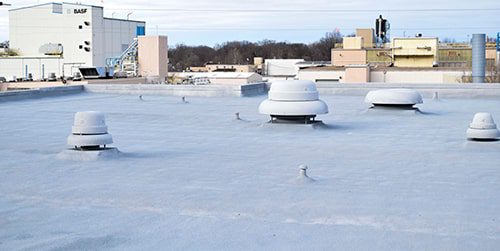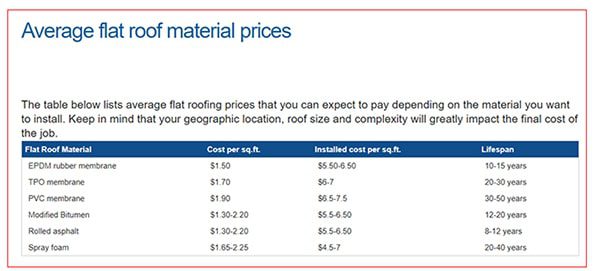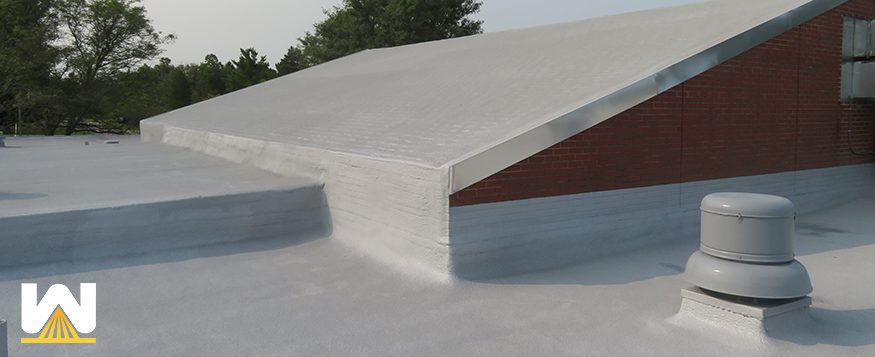Reduce Your Roofing Cost
You can reduce the cost of a commercial roofing project by minimizing the amount of tear-off. A spray foam roofing system can be applied over an existing roof, where the only areas of the roof that need to be torn off are the areas saturated with water. A traditional roofing system will remove 100% of an existing roof, whether the sections of the roof are dry or saturated. More tear-off = more money.
Let’s say that your commercial roof is leaking and you’re getting quotes from contractors. Let’s also say that your budget for the project is $100,000.
The first bid comes in at $130,000.
The second bid comes in at $132,000.
The third bid comes in at $140,000.
You’re thinking to yourself, “how come no one can do this job under budget”?
It’s times like these where you may need to think outside the box to solve your problem.
One way to think outside the box is to research different, non-traditional roofing systems that can be more cost-effective.
One of these roofing systems is what’s called spray foam roofing.
In today’s article, you’ll learn three things:
- What is spray foam roofing?
- How much does spray foam roofing cost vs other roofing systems?
- Why spray foam roofing is more cost-effective than traditional roofing systems
But how do you know we aren’t just blowing smoke, pulling wool over your eyes, or any other illusion to make you a believer in spray foam?
West Roofing Systems has been installing spray foam roofing systems since 1979.
1979!
This isn’t a new, unproven roofing system that was invented last week. Thousands and thousands of commercial roofs have been restored, renewed, or completely re-roofed with the spray foam roofing system.
Now, let’s get started.
What is spray foam roofing?

Spray Polyurethane Foam Roofing, is a material that’s sprayed as a liquid and expands into a foam, creating a fully-adhered and monolithic layer of insulation across an existing roof.
The usual application of spray foam is to repair and renew an existing roof by removing the saturated areas (if any), replacing with like materials, and then spraying foam over top of the entire roof.
Here’s a video of a spray foam installation:
How much does spray foam roofing cost vs other roofing systems?
A spray foam roof usually costs between $4 and $7 per square foot. Other traditional roofing systems, such as:
- Single-ply (mostly TPO and EPDM)
- Metal
- Gravel built-up (smooth or granulated)
These roofing systems can cost between $5 and $7 per square foot.

Source: https://www.roofcalc.org/flat-roof-calculator/
You may be thinking, “spray foam is pretty close to the costs of other systems, so where’s the big cost savings with spray foam?”.
Why spray foam roofing is more cost-effective than traditional roofing systems
This answer can come two-fold: short-term and long-term. Let’s get into the short-term.
Why is spray foam roofing cost-effective in the short-term?
The main reason is that you don’t need to remove 100% of the existing roof like you do when you install other roofing systems.
Removing a commercial roof is very costly. It requires a lot of labor hours to remove an existing roof. It’s costly to transport and dump those materials into a landfill. And it’s expensive to replace the entire roof with a new roofing system.
Example #1 with a traditional roofing system
You would remove the entire existing roof, transport everything to a landfill, and then install a new roofing system over the entire roof.
Example #2 with spray foam
Only the areas that are saturated with water get removed and replaced (usually under 25% of the roof). Only those materials get transported to a landfill, and then spray foam can be installed over the entire roof.
BONUS: The speed of installation is also related to cost. The time it takes to install a roof is directly related to the labor cost associated with the project. With spray foam not always having to remove 100% of the roof, and how easy spray foam is to install around penetrations, it can be installed in about 1/3 of the time of a traditional roofing system.
Why is spray foam roofing cost-effective in the long-term?
There are a few ways that a spray foam roof is cost-effective long-term.
The first way is through R-value. Spray foam has the highest R-value per inch of any roof insulation. If you’re unaware of what R-value is, it’s a material’s ability to resist thermal movement through it. The higher the R-value, the less heat or cool that will pass through.
This is a key component in keeping your facilities energy costs down.
Here’s a list of the R-values of popular roof insulations:
- Spray Polyurethane Foam: 6.5 per inch
- XPS Insulation: 5.0 per inch
- EPS Insulation: 3.85 per inch
- Polyiso: 5.5 per inch
The second way a spray foam roof is cost-effective long-term is because the roof can be renewed.
Once a spray foam roof lasts its warranty, which is usually 10-20 years, the roof can be renewed by power washing the roof clean and adding more coating on top of the spray foam roof.
The cost of a spray foam renewal, or re-coat, is usually 1/3 to 1/2 of the cost of the initial installation.
In comparison, after a traditional roofing systems warranty is over, usually 10-20 years, 100% of the roof will need to be removed and replaced. This will cost 100% of the cost of the initial installation.
NOTE: For a roof that costs $100,000 today, 10 years from now, you’ll likely pay about $33,333 to $50,000 for a spray foam recoat, or starting at another $100,000 for a traditional roofing system.
What’s your next step in reducing the cost of your commercial roof project?
Your next step is to learn more about spray foam roofing to see if it’s a roofing system that you’re interested in.
There are some problems with spray foam roofs.
There are issues with finding a trust-worthy spray foam roofing contractor.
But with so many property owners choosing a spray foam roof, the benefits outweigh the negatives.
West Roofing Systems has been a commercial roofing contractor since 1979. Since then, there have been many changes to building codes, changes in the Montreal Protocol that have changed the formulation of spray foam, and many other changes in the application of spray foam.
If you’d like to see if spray foam is a possibility with your roof, please fill out a request for quote form.
If you’d like to learn more about spray foam roofing, please view our Ultimate Guide to Spray Foam Roofing.


